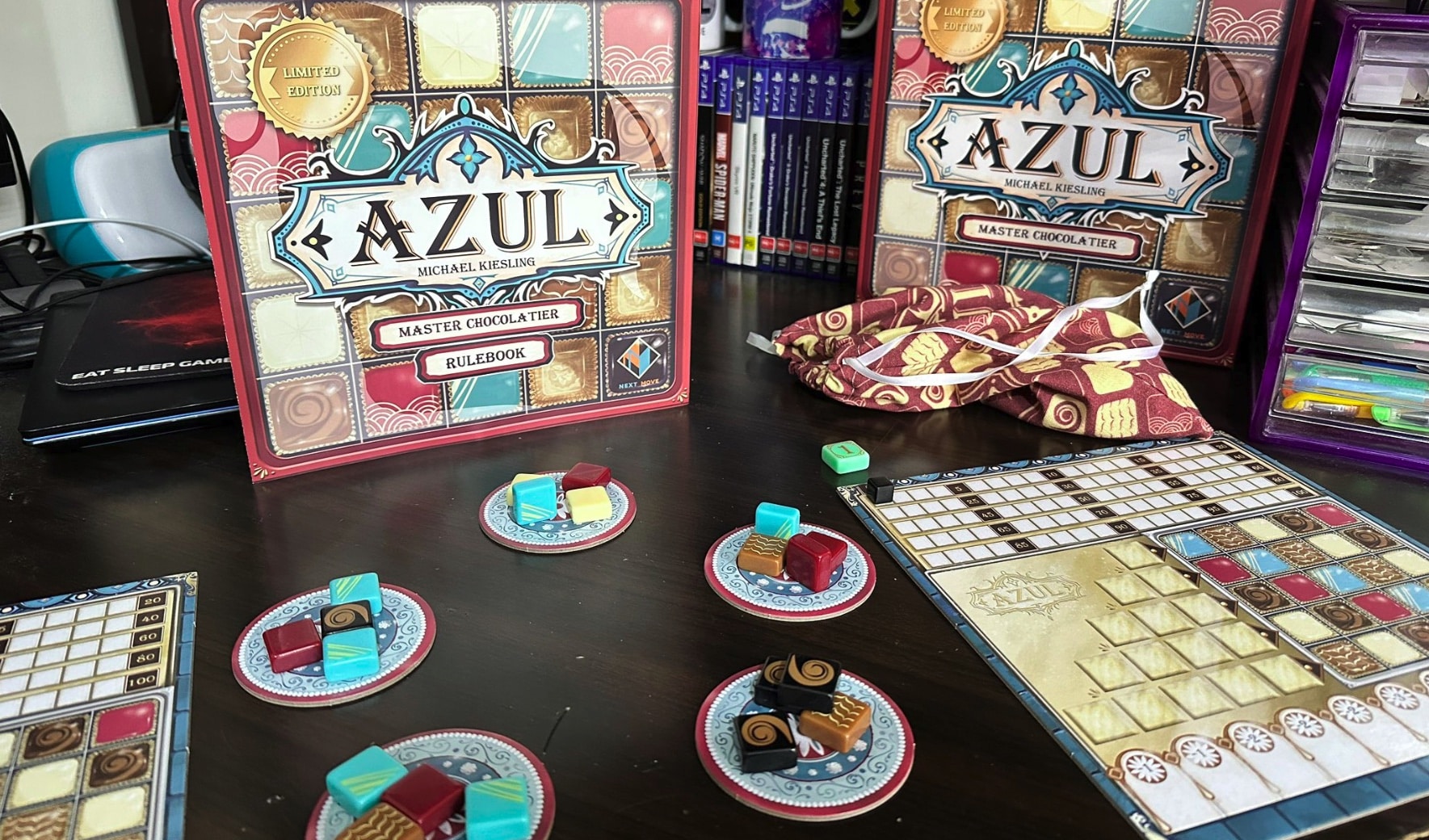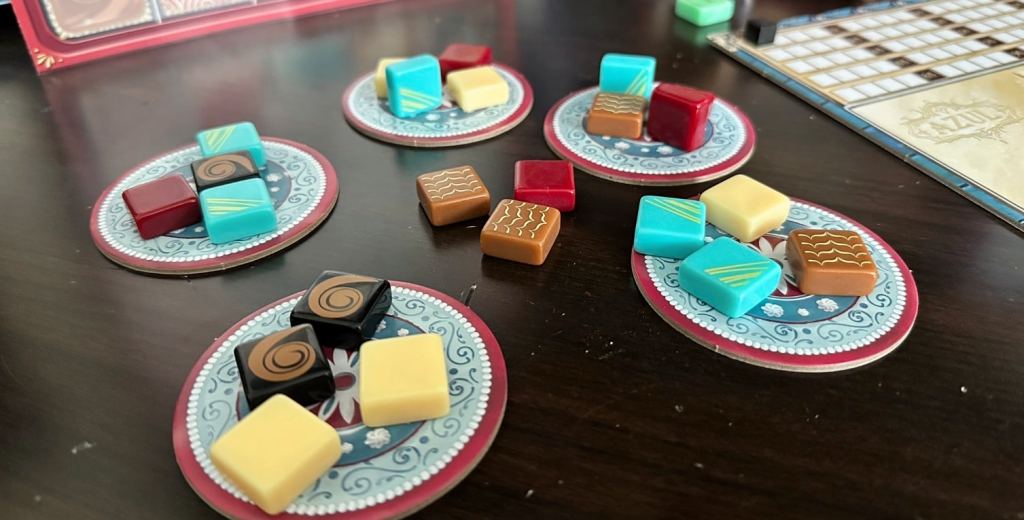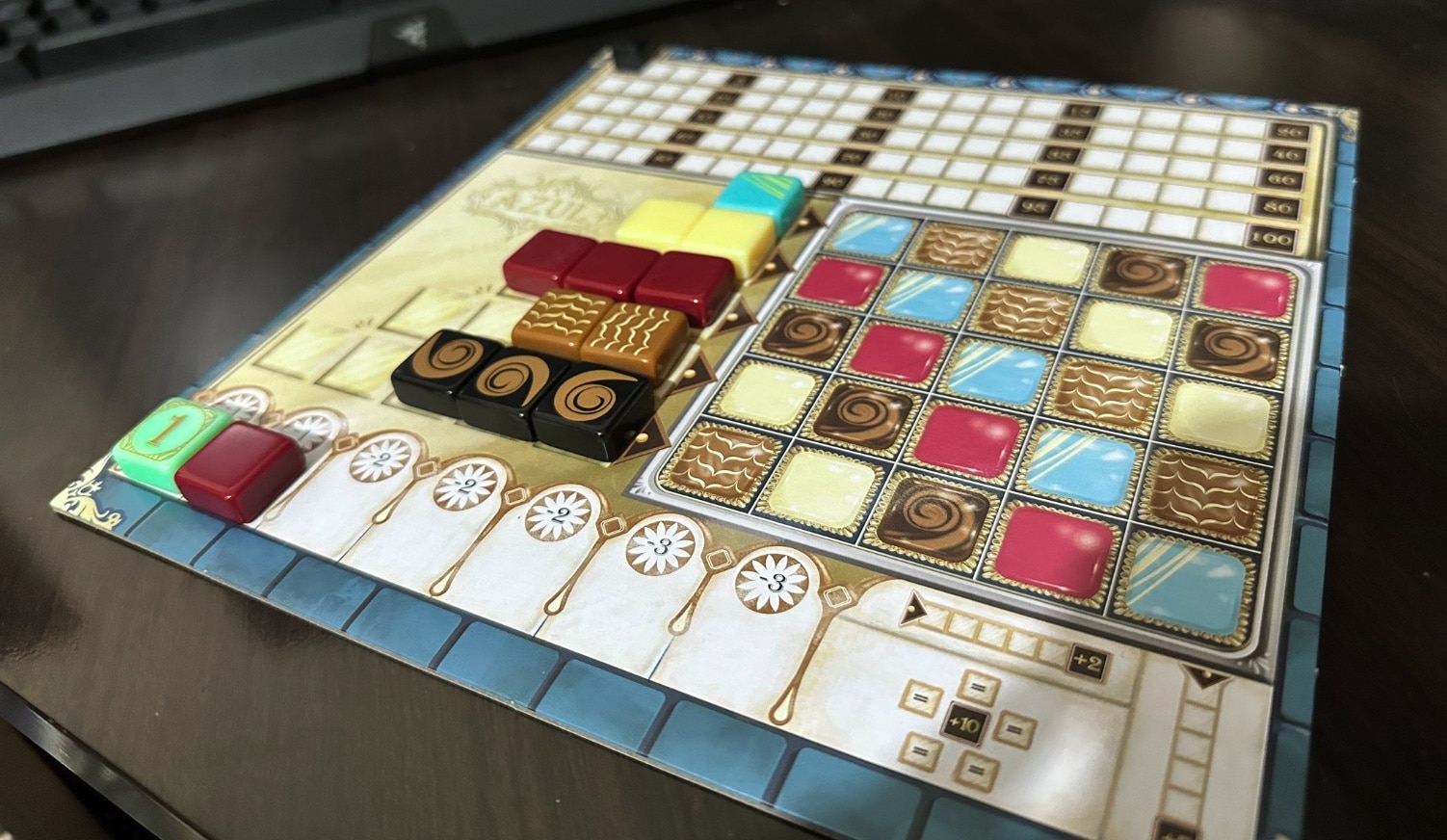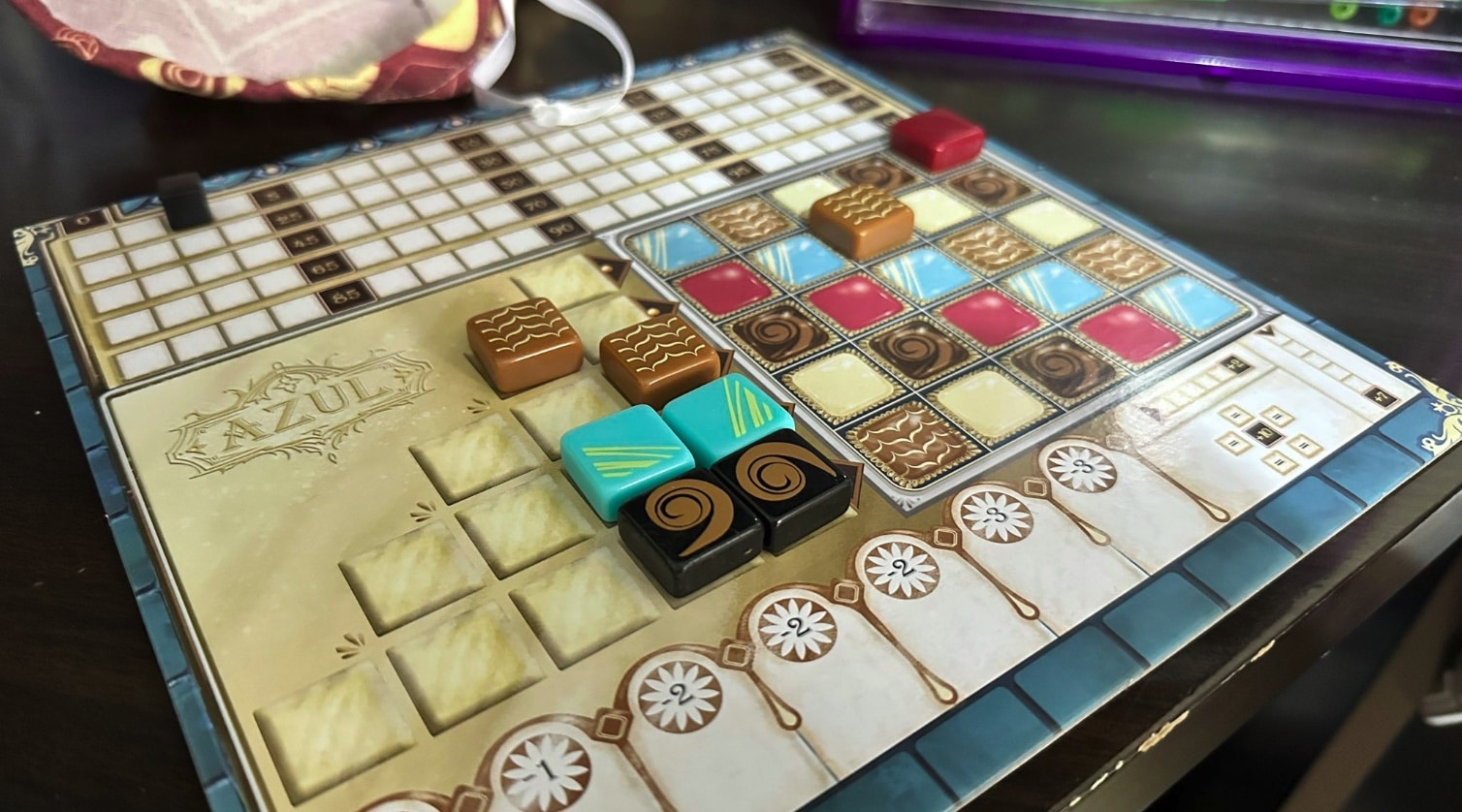Everyone has different taste in board games. Some like them casual and friendly to newcomers. Others prefer a tougher game with more rules, wild worlds, and twisting plots. But no matter what kind of player you are, it’s likely you’ll be familiar with Azul. As one of the best casual strategy board games of modern times, it’s a must-have for any good board game collection – and with its latest variant, Azul: Master Chocolatier, it’s also become a rather delicious board game snack.
Azul: Master Chocolatier largely resembles the original version of Azul. It’s a strategy game with a simple goal: to pick up enough playing pieces to fill out a patterned row. In this version, you gather special chocolates in the opening round of the game, from a selection of ‘factory’ tiles. Then, in the second phase of the game, you begin forming your chocolate patterns and rows in an attempt to get the most points.
The game ends once a single row of chocolates has been completed, with the highest score winning the game. Let’s break down how a game of Azul: Master Chocolatier works.
How to play Azul: Master Chocolatier

As with any good board game, Azul: Master Chocolatier begins with a brief learning session. The instruction booklet is extremely light, and contains only the basics you need to begin – making the game very approachable, even for those less versed in the world of board games.
The instructions are simple, and easy to teach – but they do hold some complexities beneath the surface. You can be told how to play this version of Azul and understand exactly what to do, but the strategy and mastery of the game come much later.
To kick off the action, you’ll want to breeze through the game’s instructions (5-10 minutes maximum), and set up your playing space. Up to four players can jump into Azul: Master Chocolatier together, with each having their own player board to begin building chocolate patterns.
Factory tiles are then laid out, comparative to the number of players – five for a two-player game, seven for a three-player game, and so on. Four chocolates are placed on each factory tile, and space is left between them – this eventually becomes a discard pile that can be mined.
In the first round, players must begin gathering chocolates. They do this by either selecting all tiles of the same colour from one of the factories (and discarding the rest), or by choosing all tiles of the same colour from the discard pile.
The aim is to maximise your tile collection by choosing factories with the most of one colour. In this way, you can start gathering chocolates that will eventually find a place in your Chocolate Box.

Each turn players build out their Pattern Lines, on the leftmost side of the player board, with any chocolates they’ve grabbed. The first round only ends when there are no tiles left in the centre. Players must find a place for every chocolate, or put them in their Foundry Line (which ultimately subtracts points).
Eventually, every tile will be captured – with players required to make clever and strategic choices about which tiles they’ll pick. Any tile not captured by one player can later be captured by another player – and these tiles may directly contribute to the completion of Pattern Lines.
As a result, the flow of gameplay is twofold; it’s about capturing enough chocolates to fill out your own Pattern Lines, and also preventing other players from completing theirs. If you spot a player going for a particular shape or pattern in their chocolate box, you should analyse the factory field, and decide how best to stop them.
In a less competitive game, you can also let this slide and focus on your own board – but this comes with its own risks.
Once all the chocolates in the first round are claimed, the ‘Box Confection’ round begins. Here, players are able to transfer their completed Pattern Lines to the rightmost side of their player board – the ‘Chocolate Box’ where points are scored. Every completed pattern line allows players to transfer one chocolate onto the rightmost side of their board, discarding the other tiles.
Depending on pattern alignment, these placements can earn you a higher score, and contribute on your path to victory. For example, every adjacently placed tile gives you an extra point – and these stack horizontally and vertically.

After each round, the factory field is reset, and players continue to grab chocolates to fill out their Chocolate Box. As mentioned, the first player to fill out an entire row ‘ends’ the game, with scores tallied after every remaining chocolate has been picked and placed.
In Azul: Master Chocolatier, strategy is king…
As a lightweight strategy game, it’s easy to underestimate the complexity of Azul: Master Chocolatier. But like the original game, it’s far deeper than its simple tokens and player boards suggest. It’s not just about filling board rows with chocolate – it’s a game of 4D chess, where every opponent has the potential to ruin your best-laid plans.
Say you’re pursuing a strategy of maximising your points by creating double rows – this strategy will win you a phenomenal amount of points, if successful. If you’re able to get the right amount of chocolates and every colour you need, it’s a great achievement that will likely maximise your score. But anyone watching your board can block your attempt by grabbing the coloured pieces you need, and decimating the factory floor.
There’s also a layer of chance to this strategy. Every round, the board is refreshed and you don’t know what pieces will be drawn from the tile bag. You might end up with a factory full of brown chocolates, allowing you to complete a row. You might end up with a completely random factory, and have to claw your way to victory piece by piece.
Every possibility must be accounted for if you’re doggedly pursuing the win, making each tile pick critical for the final result. If you choose badly and don’t account for other players being crafty, you’ll likely come up short.
…But there’s room for casual play, too

Importantly, Azul: Master Chocolatier is multi-modal. It’s great for deeper thinkers looking for a competitive strategy game, but it’s also perfect for those low-speed board game nights. Sometimes, you want to take your foot off the pedal, and relax with a low-key puzzler.
Azul: Master Chocolatier can certainly be played that way. If you’re facing off with an ultra-competitive player, expect the experience to be fast-paced and vicious. But there’s room for the rest of everyone here, and play can be slowed down as you desire. New players will likely breathe a sigh of relief knowing this – anyone can jump into this game and not feel disadvantaged for lack of experience.
Personally, I preferred this game as a slower, mindful exercise – with a breathable pace, players can sit together, chat alongside gameplay, and enjoy this wonderful-looking treat without stressing too much about the minutiae of picking tiles.
Final Verdict
While Azul: Master Chocolatier doesn’t significantly change up the classic Azul formula, it does maintain its sense of accessible, strategy-based gameplay that feels perfect for players of every level. Azul is a staple of the board game diet, and this version feels just as essential. You won’t need both, but if you’re looking for another gorgeous version of the classic strategy game, Master Chocolatier has you covered.
Fair warning, the pieces do look good enough to eat – but that’s only a minor distraction as you work your way through tense rounds of chocolate picking and packing. Elements of chance and the potential for gameplay to fire up intensely help to keep the action moving, and provides a range of valid gameplay options that’ll easily match your preference.
With a good mix of ‘easy to learn, hard to master’ gameplay, Azul: Master Chocolatier is a wonderful experience, and a great spin on a modern board game classic.
Four stars: ★★★★
Azul: Master Chocolatier
Designer: Michael Kiesling
Publisher: Next Move Games
Release Date: 2022
A copy of Azul: Master Chocolatier was provided and played for the purposes of this review.





